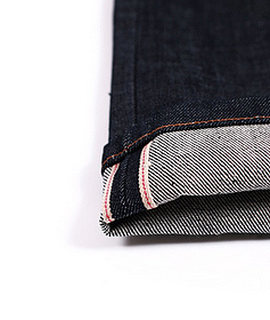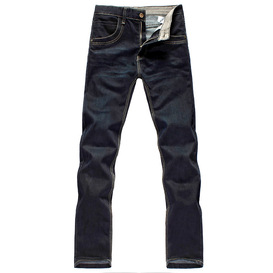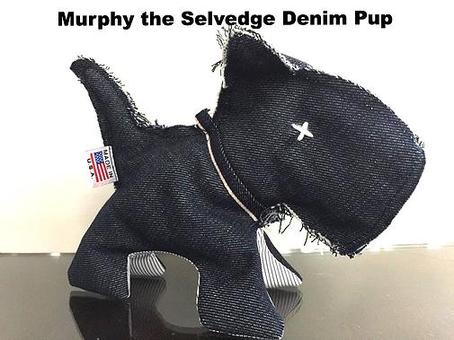understanding raw & selvedge denim
Courtesy of Brett & Kate McKay TheArtofManliness.com

While denim jeans have been a clothing staple for men since the 19th century, the jeans you’re probably wearing right now are a lot different from the denim jeans that your grandpa or even your dad wore.
Before the 1950s, most denim jeans were crafted from raw and selvedge denim that was made in the United States. But in the subsequent decades, as denim went from workwear to an everyday style staple, the way jeans were produced changed dramatically. With the implementation of cost cutting technologies and the outsourcing of manufacturing jobs to developing countries, the quality of your average pair was greatly reduced. Changes in consumer expectations altered the denim landscape as well; guys wanted to pick up pre-washed, pre-faded, pre-broken-in, and even pre-“ripped” jeans that “looked” like they’d been worn for years.
But about a decade ago, the pendulum began to swing back again. Men started pushing back against the low-quality, cookie-cutter, pre-faded jean monopoly. They wanted a quality pair of denim jeans and to break them in naturally. They wanted to pull on the kind of American-made dungarees their grandpas wore.
To give us the scoop on raw and selvedge denim, we talked to Josey Orr (fast fact: Josey was named after the protagonist in The Outlaw Josey Wales), co-founder of Dyer and Jenkins, an L.A.-based company that’s producing raw and selvedge denim right here in the United States.
Note: This is not a sponsored post. I just hit up Josey for the inside dope on denim because he’s a cool young dude who makes awesome jeans, has an awesome beard, and knows his stuff.
To first understand raw and selvedge denim jeans, it helps to know what those terms even mean.
Before the 1950s, most denim jeans were crafted from raw and selvedge denim that was made in the United States. But in the subsequent decades, as denim went from workwear to an everyday style staple, the way jeans were produced changed dramatically. With the implementation of cost cutting technologies and the outsourcing of manufacturing jobs to developing countries, the quality of your average pair was greatly reduced. Changes in consumer expectations altered the denim landscape as well; guys wanted to pick up pre-washed, pre-faded, pre-broken-in, and even pre-“ripped” jeans that “looked” like they’d been worn for years.
But about a decade ago, the pendulum began to swing back again. Men started pushing back against the low-quality, cookie-cutter, pre-faded jean monopoly. They wanted a quality pair of denim jeans and to break them in naturally. They wanted to pull on the kind of American-made dungarees their grandpas wore.
To give us the scoop on raw and selvedge denim, we talked to Josey Orr (fast fact: Josey was named after the protagonist in The Outlaw Josey Wales), co-founder of Dyer and Jenkins, an L.A.-based company that’s producing raw and selvedge denim right here in the United States.
Note: This is not a sponsored post. I just hit up Josey for the inside dope on denim because he’s a cool young dude who makes awesome jeans, has an awesome beard, and knows his stuff.
To first understand raw and selvedge denim jeans, it helps to know what those terms even mean.
what is raw denim?
Most denim jeans you buy today have been pre-washed to soften up the fabric, reduce shrinkage, and prevent indigo dye from rubbing off. Raw denim (sometimes called “dry denim”) jeans are simply jeans made from denim that hasn’t gone through this pre-wash process.
Because the fabric hasn’t been pre-washed, raw denim jeans are pretty stiff when you put them on the first time. It takes a few weeks of regular wear to break-in and loosen up a pair. The indigo dye in the fabric can rub off as well. We’ll talk more about this when we go over the pros and cons of raw denim below.
Raw denim (all denim actually) comes in two types: sanforized or unsanforized. Sanforized denim has undergone a chemical treatment that prevents shrinkage after you wash your jeans. Most mass-produced jeans are sanforized, and many raw and selvedge denim jeans are too. Unsanforized denim hasn’t been treated with that shrink-preventing chemical, so when you do end up washing or soaking your jeans, they’ll shrink by 5%-10%.
Because the fabric hasn’t been pre-washed, raw denim jeans are pretty stiff when you put them on the first time. It takes a few weeks of regular wear to break-in and loosen up a pair. The indigo dye in the fabric can rub off as well. We’ll talk more about this when we go over the pros and cons of raw denim below.
Raw denim (all denim actually) comes in two types: sanforized or unsanforized. Sanforized denim has undergone a chemical treatment that prevents shrinkage after you wash your jeans. Most mass-produced jeans are sanforized, and many raw and selvedge denim jeans are too. Unsanforized denim hasn’t been treated with that shrink-preventing chemical, so when you do end up washing or soaking your jeans, they’ll shrink by 5%-10%.
what is selvedge denim?

To understand what “selvedge” means, you need to understand a bit of history on fabric production.
Before the 1950s, most fabrics — including denim — were made on shuttle looms. Shuttle looms produce tightly woven strips (typically one yard wide) of heavy fabric. The edges on these strips of fabric come finished with tightly woven bands running down each side that prevent fraying, raveling, or curling. Because the edges come out of the loom finished, denim produced on shuttle looms are referred to as having a “self-edge,” hence the name “selvedge” denim.
During the 1950s, the demand for denim jeans increased dramatically. To reduce costs, denim companies began using denim created on projectile looms. Projectile looms can create wider swaths of fabric and much more fabric overall at a much cheaper price than shuttle looms. However, the edge of the denim that comes out of a projectile loom isn’t finished, leaving the denim susceptible to fraying and unraveling. Josey pointed out that contrary to what you may hear from denim-heads, denim produced on a projectile loom doesn’t necessarily equate to a poorer quality fabric. You can find plenty of quality jean brands from denim made on projectile looms.
Most jeans on the market today are made from non-selvedge denim. The pros of this have been the increased availability of affordable jeans; I recently needed a pair of jeans in a pinch while on a trip and was able to score a pair of Wrangler’s at Walmart for just $14. But consumers have been missing out on the tradition and small quality details of classic selvedge denim without even knowing it.
Before the 1950s, most fabrics — including denim — were made on shuttle looms. Shuttle looms produce tightly woven strips (typically one yard wide) of heavy fabric. The edges on these strips of fabric come finished with tightly woven bands running down each side that prevent fraying, raveling, or curling. Because the edges come out of the loom finished, denim produced on shuttle looms are referred to as having a “self-edge,” hence the name “selvedge” denim.
During the 1950s, the demand for denim jeans increased dramatically. To reduce costs, denim companies began using denim created on projectile looms. Projectile looms can create wider swaths of fabric and much more fabric overall at a much cheaper price than shuttle looms. However, the edge of the denim that comes out of a projectile loom isn’t finished, leaving the denim susceptible to fraying and unraveling. Josey pointed out that contrary to what you may hear from denim-heads, denim produced on a projectile loom doesn’t necessarily equate to a poorer quality fabric. You can find plenty of quality jean brands from denim made on projectile looms.
Most jeans on the market today are made from non-selvedge denim. The pros of this have been the increased availability of affordable jeans; I recently needed a pair of jeans in a pinch while on a trip and was able to score a pair of Wrangler’s at Walmart for just $14. But consumers have been missing out on the tradition and small quality details of classic selvedge denim without even knowing it.
don't confuse selvedge with raw
A common misconception is that all selvedge denim jeans are raw denim jeans and vice versa. Remember, selvedge refers to the edge on the denim and raw refers to a lack of pre-washing on the fabric.
While most selvedge jeans on the market are also made with raw denim, you can find jeans that are made from selvedge fabric but have been pre-washed, too. You can also find raw denim jeans that were made in a projectile loom, and thus don’t have a selvedge edge.
Make sure to keep this distinction in mind when you start shopping for selvedge or raw jeans.
While most selvedge jeans on the market are also made with raw denim, you can find jeans that are made from selvedge fabric but have been pre-washed, too. You can also find raw denim jeans that were made in a projectile loom, and thus don’t have a selvedge edge.
Make sure to keep this distinction in mind when you start shopping for selvedge or raw jeans.

